This website uses cookies
This website uses cookies to enable it to function properly and to analyse how the website is used. Please click 'Close' to accept and continue using the website.


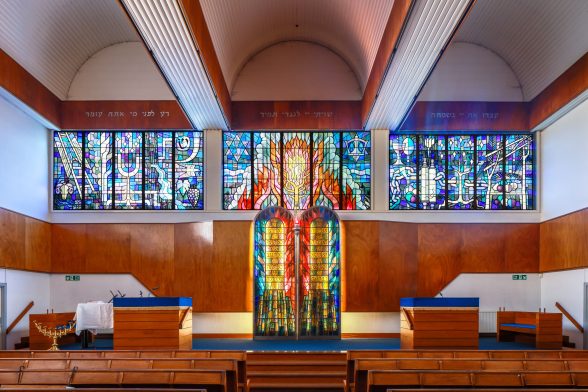
Image credit: John East
We’re delighted to announce that Brighton and Hove Reform Synagogue has been Grade II listed following an application by the Society, saving the modernist building and its extraordinary stained-glass windows from the unthinkable prospect of demolition.
As well as being a place of worship, the building itself is a dedicated memorial to the victims of the Holocaust, which is believed to be a unique dedication in the UK and Internationally. Its luminescent, 40ft long stained-glass windows, by artist John Petts have been described by art historian Dr Alison Smith as “one of the great religious artworks of the 20th century”, and by historian and broadcaster Simon Schama as “a ravishing and exquisite work of Judaic art”.
Responding to the news of listing, Olivia Marks-Woldman OBE, Chief Executive of the Holocaust Memorial Day Trust, said “This is far more than a building; it’s a place of memory, of community and of profound emotional significance. In protecting this space, we’re also safeguarding the stories, the lives and the lessons it holds.”


‘List or Lose It’
Designed by architects Derek Sharp Associates and built between 1966-67, in 2023 the synagogue was threatened by plans from a local developer that would have seen the historic building make way for a block of 18 residential flats, with a smaller replacement synagogue apologetically placed elsewhere on the site.
C20 Society first applied to list the synagogue in 2017 in response to prior approval being granted for its demolition, yet Historic England disappointingly recommended against listing in 2018. This previously consented scheme subsequently fell-through and important new evidence emerged regarding the rarity and significance of the stained-glass windows. This prompted a new listing application by the Society in August 2023, and inclusion on the recent C20 Risk List campaign of the 10 most threatened buildings across the country, trailed by a nationwide ‘List it or Lose it’ billboard campaign featuring the synagogue.
After an agonising 18 month wait, Historic England and DCMS finally confirmed a Grade II listing designation in April 2025, to the relief of local campaigners.
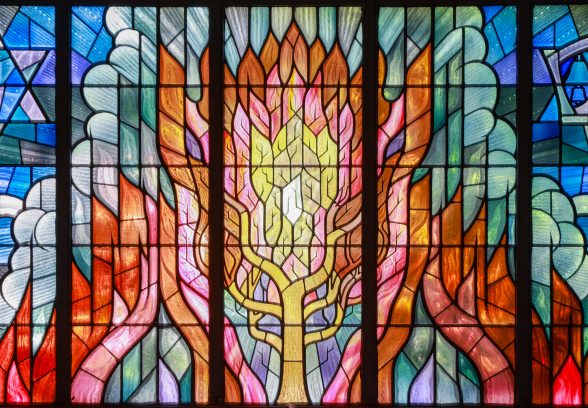
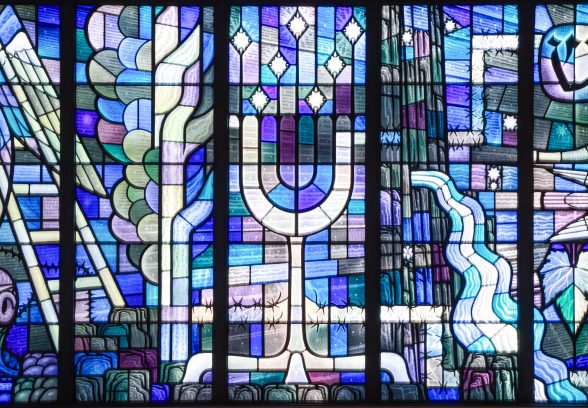
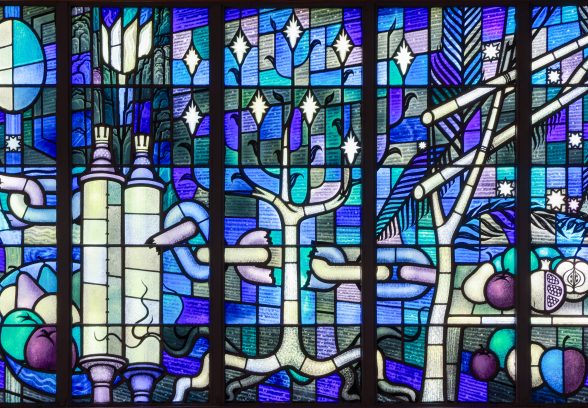
Stained Glass
The central features of the synagogue are its memorialising Ark and 40ft long stained-glass windows, designed by artist John Petts. As a regular place of worship, the idea of graphically representing concentration camps in the window was rejected, instead an iconographic programme expressing the historic persecution of Jews was developed, using motifs referencing the Hebrew Bible and Jewish feasts, composed of some 1,800 individual pieces of vibrant coloured glass and images subtly interwoven with barbed wire and chains broken by a sapling.
The use of stained glass for a memorial of this type is rare in Britain, and no other example on this scale is known. Historians have drawn comparison to Picasso’s seminal painting Guernica (1937), and the way both artworks articulate the personal, emotional and historical dimensions of modern warfare and the atrocities it has engendered.
The windows have been identified by the Imperial War Museum as a Holocaust memorial and are the most significant example of Petts work in UK, yet are not as widely recognised as they should be. It was long felt that they should not be advertised lest they fall victim to anti-Semitic attack (as indeed they did during the 1970s), and initial plans for an external inscription were abandoned. The foundation stone in the foyer reads: ‘In dedication to the glory of God and in memory of the 6 million Jews who perished in the concentration camps during the 1939-1945 World War./ In honour of the dead as a warning to the living’.
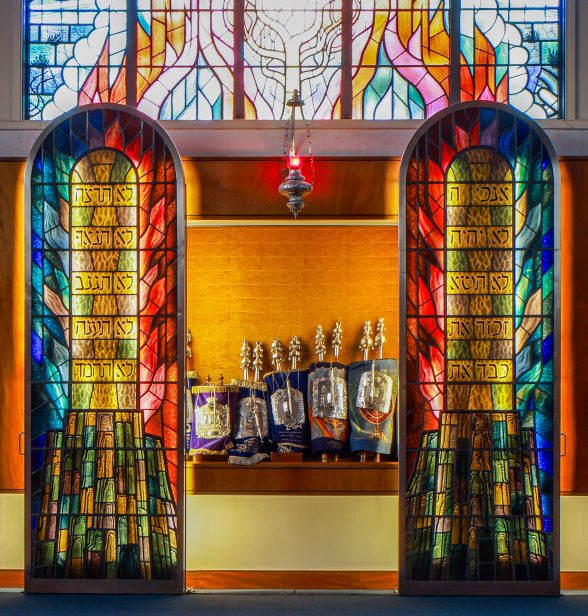
John Petts and the Alabama ‘Wales Window’
Such was the ambition for the new Synagogue, Rabbi Erwin Rosenblum (a Holocaust survivor himself) initially approached artist Marc Chagall to undertake the commission for the windows. Instead John Petts was chosen, given his international standing at the time as the creator of the Wales Window for the 16th St Baptist Church in Birmingham, Alabama.
On the 15th of September 1963, the Ku Klux Klan planted a bomb at the 16th Street Baptist Church, Birmingham, Alabama, that killed four black girls attending Sunday school and destroyed parts of the church. News of the bombing reached artist John Petts in Llansteffan, Carmarthenshire, whereupon he quickly offered his services to create and install a replacement window. A front-page campaign in the Welsh press helped raise funds for the venture, and within just two years Petts had delivered his gift from the people of Wales.
The church has since become an important historical landmark, attracting thousands of visitors each year, and the window is regarded as one of the key icons of the American Civil Rights Movement – a powerful protest against intolerance and injustice. It’s the most celebrated international example of Petts work and is believed to be among the first depictions of Christ as a Black man in this medium.
The Brighton windows invite clear comparison to the Alabama window, in terms of their deep colour and sensitive iconographic scheme, with each element conveying a particular religious and wider humanitarian message.
John Petts (1914-1991) was born in London though spent his working life in Wales, abandoning his studies at the Royal Academy in 1935, to move to Snowdonia with his wife, the artist Brenda Chamberlain. Petts began his creative practice as a wood engraver, though from 1961 until his death in 1991 he was engaged as a stained glass designer, primarily of memorial windows, the majority of which are located in Dyfed, Glamorgan and Gwent.
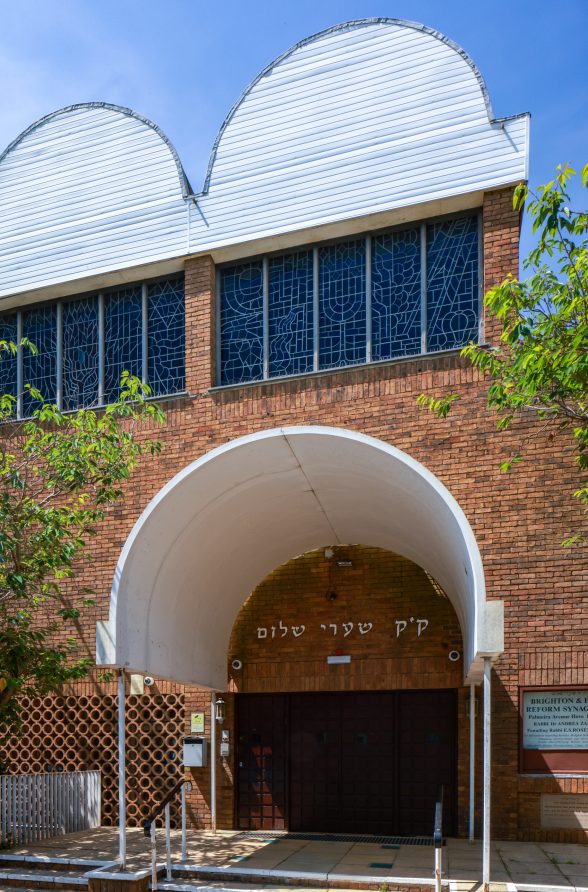
Image credit: John East
Community and modernity
With its triple barrel-vaulted roof, perforated brick screens and slender semi-circular concrete canopy, the Synagogue is a distinctively modernist yet discreet presence in leafy residential streets of Brighton and Hove. The four storey building stands at the corner of Palmeira Avenue and Eaton Road, neighboring the Sussex County Cricket Ground.
Internally, its key spaces are remarkably well preserved, with the triple vault of the prayer hall recalling the interior of the 17th-century Portuguese Synagogue of Amsterdam, and able to accommodate up to 630 worshippers. The construction was a community endeavour, with every member of the synagogue asked to donate towards the new building and contribute “even just a brick”. Records show one child, a Roger Burkeman, donating £1 of pocket money in 1966. The congregation at the time was composed largely of tradespeople, who would have had the collective expertise to obtain the best materials that money could buy, as can be seen in the mahogany furniture and fittings.
Post-war Jewish heritage
Historic England have acknowledged that Jewish heritage is currently under-represented on the national register, with the Synagogue at Carmel College in South Oxfordshire (1963) the only other listed post-war synagogue in England. Approximately 150 post-war churches are nationally listed.
There are thought to be approximately 50 listed Second World War Memorials in England, of which only one is dedicated to the victims of the Holocaust – the ‘Memorial sculpture group’ in Gladstone Park, Dollis Hill in London (c. 1967-68).
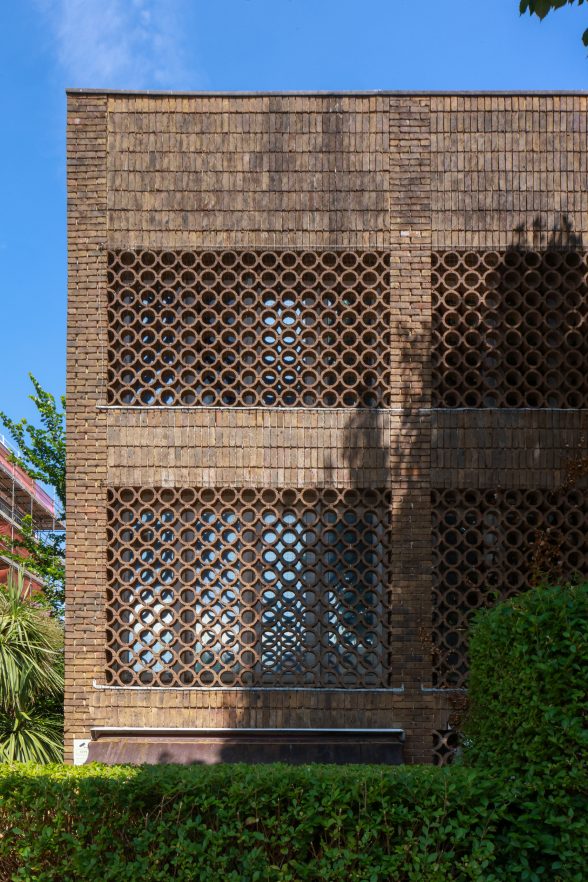
Image credit: John East
Comments
Catherine Croft, Director at C20 Society:
“The Brighton and Hove Synagogue has outstanding cultural significance: its post-war architecture and artwork is exceptional, and it has major communal value as a Holocaust memorial and as a social and spiritual centre. With the 80th anniversary of the liberation of Auschwitz being commemorated in 2025, the destruction of this luminescent memorial would have been unthinkable. It richly deserves its place on the National Register.”
Dr Alison Smith, Director of Collections and Research at the Wallace Collection, previously Chief Curator at the National Portrait Gallery:
“Brighton and Hove Reform Synagogue is unique in that it serves as a memorial as well as a place of worship, and as such it was intended to last for generations. The John Petts windows stand as one of the great religious works of art of the 20th century, comparable to John Piper’s stained glass in Coventry Cathedral, in encapsulating the suffering and enduring spirit of Jewish people in the face of the horrors unleashed during the Holocaust. I can think of no comparable Holocaust memorial of this scale and quality in the UK. The listing is great news for Brighton and East Sussex, and brings so much potential. I hope the council of the synagogue can now take advantage of this opportunity and open it up for visitors.”
Olivia Marks-Woldman OBE, Chief Executive of the Holocaust Memorial Day Trust:
“We’re delighted that Brighton & Hove Reform Synagogue has been granted Grade II listed status. This is far more than a building; it’s a place of memory, of community and of profound emotional significance. In protecting this space, we’re also safeguarding the stories, the lives and the lessons it holds. This recognition is a vital step in preserving a remarkable example of post-war Jewish landmarks while also strengthening efforts to keep Holocaust memory alive in the face of rising antisemitism and historical distortion. We hope it will inspire further protection of places that bear witness to Jewish heritage, resilience, and remembrance.”
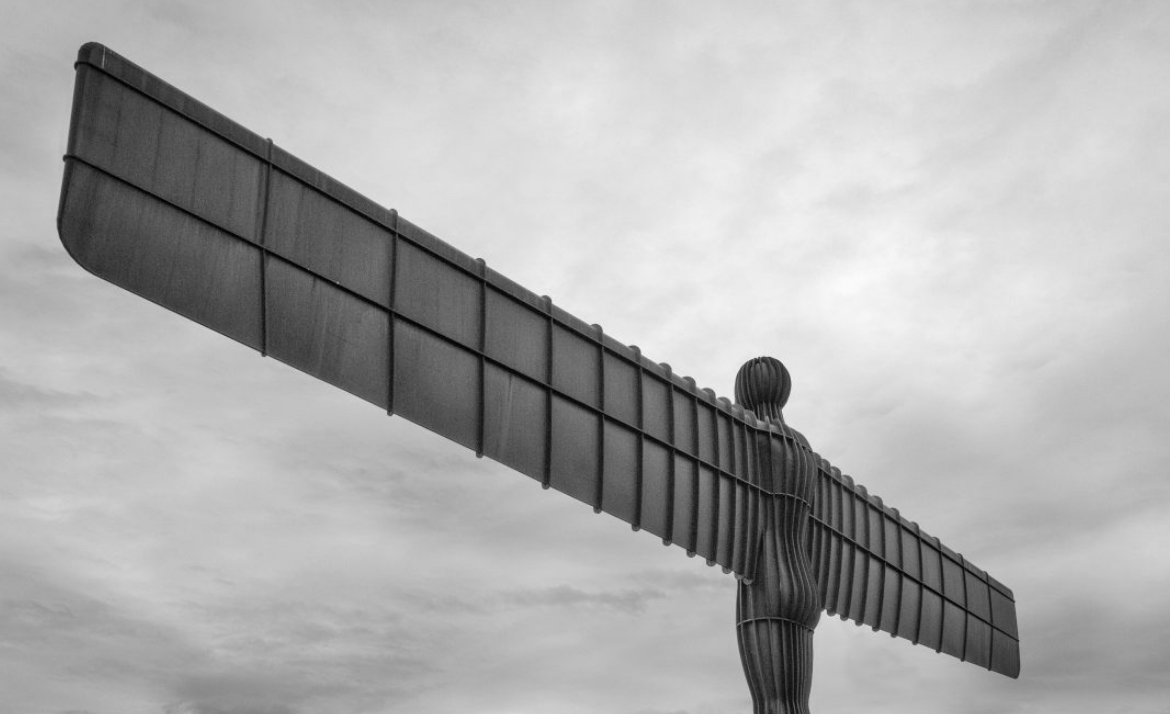
Become a C20 member today and help save our modern design heritage.